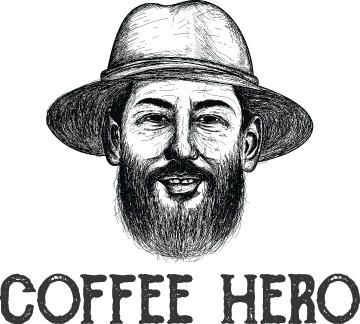
THE ROAST IS THE RECIPE
THE ROAST IS THE RECIPE
The Roast Code: A Master Guide on How Coffee Roast Level Changes Everything in Your Brew

You've finally mastered the art of brewing. You weigh your beans, time your pours, and hit the right temperature. But why does that bright, fruity Ethiopian coffee taste sour, while the dark, heavy Brazilian blend you bought tastes bitter and burnt?
The answer is simple, but often missed: Your coffee's roast profile is your primary recipe.
Every bean requires specific, deliberate adjustments to the way you grind, the temperature of your water, and how long you brew. If you treat a light roast the same as a dark roast, you are guaranteeing a disappointing cup. This guide will decode the roasting process and give you the precise playbook for extracting perfect flavour from every bean, every time.
The Scientific Transformation: What Happens in the Roaster
Before you can brew the coffee, you need to understand the fundamental transformation that happens inside the roaster. The roast level isn't just a color; it’s a chemical blueprint that dictates how easily the flavour compounds will dissolve in your water.
Phase 1: The Drying and Browning Stage
When green beans enter the roaster, the first job is to remove all their moisture. The beans then start to turn yellow and brown. This color change is a complex chemical process known as the Maillard Reaction, where heat causes sugars and amino acids to combine, creating hundreds of the delicious aromas and chocolate, nutty, and caramel notes we associate with coffee. This phase builds the sweetness foundation of your coffee.
Phase 2: First Crack and Development
At around 200 C (392 F), the beans make a distinct popping sound, much like popcorn. This is the First Crack, signaling that the internal steam pressure has burst the cellular structure of the bean.
The time between the First Crack and when the beans are removed is called the Development Phase. This is the roaster's most critical period, where flavour is set.
-
Light Roast: Removed early in this phase. The beans are dense, hard, and resist water.
-
Dark Roast: Left until or past the Second Crack (a shallower, snapping sound). The bean becomes light, brittle, and highly porous, it practically dissolves in water.
This transformation is the key: The darker the roast, the more porous the bean, and the faster the flavour will rush out.
Brewing Masterclass by Roast Profile
This section provides the essential, actionable adjustments you must make based on the final roast colour.
A. The Light Roast Code (Bright, Acidic, Floral)
Light roasts are taken out of the roaster early to preserve the bean's unique origin characteristics, like citrus, berry, or floral notes. They are dense and resist water, making them the most challenging roast to brew correctly.
The Fix: You need to be aggressive with your brewing to force the flavour out of the dense bean structure.
-
Grind Size: Go Finer.
-
Since the beans are so hard and dense, water has trouble penetrating them. You must increase the surface area by grinding finer than you would for a medium roast. This is the single most important adjustment.
-
If your light roast tastes sour, your grind is too coarse.
-
-
Water Temperature: Use Hotter Water.
-
You need maximum energy to dissolve the flavour compounds locked inside the dense bean. Use water that is at the high end of the brewing range, 94 C to 98 C (201 F to 208 F).
-
-
Brew Time: Allow Longer Contact.
-
Expect a slightly longer total brew time (3:30 to 4:30 minutes for a pour-over) to give the water the time it needs to fully extract the flavour.
-
B. The Medium Roast Code (Balanced, Sweet, Caramel)
The medium roast is the sweet spot - the balance between the original bean flavour and the roast-developed caramel and chocolate notes. They are the most forgiving and the best place to start.
The Fix: Use the universally accepted "Golden Rule."
-
Grind Size: Right in the Middle.
-
Use a true "medium" grind, about the consistency of coarse sand.
-
Find the perfect balance with our curated medium roast blends.
-
-
Water Temperature: The Middle Ground.
-
Aim for the middle of the optimal temperature range: 90 C to 94 C (195 F to 201 F).
-
C. The Dark Roast Code (Bold, Smoky, Low Acidity)
Dark roasts are left in the roaster until or past the second crack. They are lighter in weight, very brittle, and have a porous, sponge-like structure. They are also prone to releasing oils onto the surface.
The Fix: You must be gentle with your brewing to slow down the quick extraction and avoid bitterness.
-
Grind Size: Go Coarser.
-
Dark beans are highly porous, meaning water penetrates them easily and quickly. If you use a medium grind, the coffee will over-extract instantly and taste bitter and dry.
-
You must grind coarser to reduce the surface area and slow the extraction down.
-
-
Water Temperature: Use Cooler Water.
-
High heat will aggressively pull out the final, bitter, and ashy compounds from the porous bean. Use water on the cooler end of the brewing range, 86 C to 90 C (187 F to 195 F). Lower temperature means a gentler extraction.
-
-
Brew Time: Shorter Contact Time.
-
Aim for a faster brew time (2:00 to 3:00 minutes) to prevent over-extraction.
-
Beyond Filter Coffee: Espresso and Immersion Methods
The principles of roast level apply across all brewing methods.
Espresso: The Pressure Problem
Espresso uses pressure, but the same rules of density apply:
-
Light Roast Espresso: The shots often run too slow (or "choke") because the dense grounds are hard to push water through. The fix is to grind slightly coarser or use a longer extraction time (e.g., 35 seconds) to fully extract the flavour.
-
Dark Roast Espresso: The shots run too fast because the grounds are brittle and porous. The fix is to grind slightly finer and use a cooler temperature to reduce the bitterness.
French Press and Cold Brew
-
French Press (Immersion): Since the coffee and water steep for a long time, dark roasts require a very coarse grind and a shorter steep time (e.g., 3 minutes) to avoid that dry, metallic bitterness.
-
Cold Brew: The low temperature naturally reduces acidity, which is why medium and dark roasts are often preferred for their easy extraction and classic chocolate/nutty profile.
Advanced Troubleshooting: Using the Roast Code to Fix Your Cup
Stop guessing when your coffee tastes bad. Use your taste buds as your diagnosis tool and the roast profile to find the solution.
| If Your Coffee Tastes... | It Means... | And the Most Likely Cause is... |
| Sour/Sharp | Under-Extraction (You didn't get enough flavour out). | Grind is too coarse, or Water is too cold. |
| Bitter/Dry | Over-Extraction (You pulled out the wrong, harsh compounds). | Grind is too fine, or Water is too hot. |
| Flat/Weak | Correct extraction, but not strong enough. | You need to use more coffee (a tighter ratio, e.g., 1:15). |
The Roaster's Secret: If your Light Roast is Sour, you need to grind finer (or use hotter water). If your Dark Roast is Bitter, you need to grind coarser (or use cooler water).
This system gives you the power to adjust to the specific needs of the coffee you are brewing, not just a static recipe.
-
View our precision scales to measure your roast adjustments perfectly.
-
Learn more about the core science of extraction from the Specialty Coffee Association.
Your New Authority
By understanding how heat and time change the coffee bean, you stop being a recipe follower and become a true flavour designer. You now possess the Roaster’s Code. This knowledge allows you to troubleshoot any cup, perfect any roast, and consistently achieve coffee that is clear, sweet, and perfectly balanced.
Stop accepting okay coffee. Start designing incredible coffee.
The secret to mastery is having the right tools. Upgrade your grinder and start brewing your perfect cup today.
Direct link to the Coffee Hero Variety Subscription (to experiment with all roast levels).
Freshly Roasted Specialty Coffee Beans Delivered Australia Wide
As soon as we roast our beans they are packed and shipped to you immediately. When it arrives at your doorstep, it’ll be the freshest coffee you’ve ever tasted. Order online for delivery.


